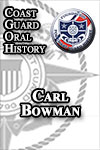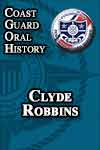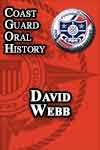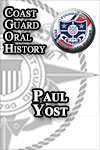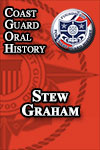We are interested in your story. To learn more about how to conduct an oral history, please visit our Conducting An Oral History Interview page.

The following histories are retrieved from the USCG Historian site
Joseph Etienne
Joseph Etienne, who during his 30-year Coast Guard career served on Prohibition enforcement aboard CGC Champlain, as a surfman at a lifeboat station, participated in the invasion of Guadalcanal (he was a shipmate of Douglas Munro aboard the USS Hunter Liggett), and post war assignments in aids to navigation where he got to know Arnold Palmer.
Clyde Allen
The oral history of Chief Damage Controlman Clyde Allen USCG (Ret.). Chief Allen served during World War II and retired from active duty in 1965. He had a variety of duty posts during his Coast Guard career, including the service with the Beach Patrol, the troop transports USSGeneral Hugh L. Scott and the USS General H. F. Hodges, ocean station duty aboard theMinnetonka, LORAN construction duty aboard the Kukui, a tour aboard the buoy tenderSweetbrier in Alaska, and patrol duty aboard the Morris. He is the father of the Commandant of the Coast Guard, Admiral Thad Allen, USCG.
Kelly Clifton
Kelly Clifton joined the Coast Guard at the end of World War II and, after attending radar school, was assigned to the tender Walnut where he trained as a QM striker. He saw ATON duty and supplied Loran stations, and was injured during one beaching. He also survived a tsunami in Hawaii in 1946 and helped recover bodies.

Fred Mann
The memoir of Chief Warrant Officer Fred Mann, USCG (Ret.). Mr. Mann enlisted in the Coast Guard in 1939 and retired in 1971 after 32 years of continuous service. During his career, which began aboard the old cutter Saranac, he served aboard Navy transports, where he saw considerable action at Guadalcanal, earning a Silver Star for heroism in combat in that early amphibious assault. After the war he served on a ocean station weather patrol, commanded patrol craft, saw service aboard numerous buoy tenders (and commanding one). He also had duty at many shore stations around the country.

David W. Sinclair
Captain David W. Sinclair’s memoir has provided us with his memoir of his Coast Guard career that stretched from 1935 through his retirement in 1969. He describes life as a cadet in the Coast Guard Academy’s Class of 1939, life aboard a Treasury Class cutter just prior to the U.S. entering World War II, his service in World War II, including the Greenland Patrol, flight training, and aerial patrol duties. He then goes on to describe his post-war Coast Guard career. 
William L. Sprague
Illustrated memoir of Signalman Third Class William L. Sprague who describes his World War II experiences, including Basic Training at Curtis Bay, Maryland, service in the Captain of the Port Office and on a patrol boat in Newport, Rhode Island, travel across the U.S. by train and plane, Signalman School in California, and service on board the USS Corpus Christi in the Pacific Theatre. 
Douglas M. Pierpont
One Among Many: The Memoirs of BM2 Douglas M. Pierpont, BM2 Pierpont’s exciting illustrated memoir of his service in the Coast Guard through World War II and after. He enlisted prior to Pearl Harbor and saw action as a coxswain assigned to the Boat Division aboard USS Leonard Wood–he participated in the invasions of North Africa, Sicily and then landings throughout the Pacific Theatre. After the war he served in Alaska aboard USCGC Bittersweet and Unalga. 
Tales of an Old Sea Dog
“Tales of an Old Sea Dog” A series of fascinating and informative autobiographical articles written by Captain C. William “Bill” Bailey about his distinguished 30-year career in the Coast Guard, from World War II through 1973! He commanded a total of nine cutters, including 5 buoy tenders and the Eastwind, Coos Bay and Chase. 
George C. Larsen
Radioman First Class George C. Larsen’s memoir of service & surviving the attack on Pearl Harbor. Larsen lived through the Japanese attack on Pearl Harbor while serving at a radio monitoring station. He had served on the Taney, and shortly after the attack was transferred to the Kukui, and while aboard he took part in the “liberation” of Niihau Island which had been “taken” by a downed Japanese pilot. He then saw service aboard the Tiger.

Wilbur Selbrede
An illustrated first-hand account of the Magic Carpet operation written by Seaman First Class Wilbur Selbrede in 1945. He served aboard the Joseph T. Dickman as a member of a special amphibious beach party and saw action at Okinawa and then participated in the “Operation Magic Carpet” voyages that returned former Allied Prisoners of War, some who were the survivors of the Bataan Death March in the Philippines in 1942 as well as those who had been captured on Wake Island in December, 1941, back home from Japanese P.O.W. camps.

Glen Boles
The oral history of Radioman First Class Glen Boles, who served as a radio operator during the war. RM1c Boles had spent time in Hollywood and on Broadway as an actor before joining the Coast Guard after the attack on Pearl Harbor. After attending basic training in Manhattan, he went through training as a radio operator in Atlantic City before volunteering for duty at a radio-monitoring station in Brazil. Here they intercepted German radio messages to their South American agents. RM1c Boles also includes information of his life after the war.

John Bach
John Bach: discusses his service in the Coast Guard as a sonarman during World War II. As a sonarman Bach relates information about sonar technology as well as imparts information relating to military life. He recounts training at Curtis Bay (Maryland) and sonar school (Key West, Florida) including the development of new training courses, creation of insignia, shipboard equipment shortages, and other difficulties incurred while expanding the military. Serving aboard the [USS] Thetis, [CG] a patrol boat that escorted convoys along the East Coast, he relates his shipboard role, coastal encounters with German submarines, and the basic nature of the sonar technology.

Michael Chartuk
“A Radioman in the U.S. Coast Guard” by Chief Radioman Michael Chartuk. MC Chartuk served as a radio intercept operator during World War II in a little-known Coast Guard operation to intercept coded Nazi radio messages. He served first at a radio monitoring station at Southmpton, New York and then established a radio monitoring station in the Dominican Republic.








